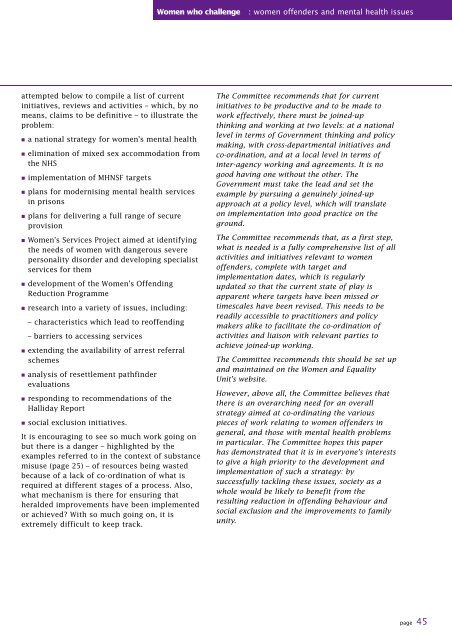Women who challenge - Nacro
Women who challenge - Nacro
Women who challenge - Nacro
- No tags were found...
You also want an ePaper? Increase the reach of your titles
YUMPU automatically turns print PDFs into web optimized ePapers that Google loves.
<strong>Women</strong> <strong>who</strong> <strong>challenge</strong>: women offenders and mental health issuesattempted below to compile a list of currentinitiatives, reviews and activities – which, by nomeans, claims to be definitive – to illustrate theproblem:• a national strategy for women’s mental health• elimination of mixed sex accommodation fromthe NHS• implementation of MHNSF targets• plans for modernising mental health servicesin prisons• plans for delivering a full range of secureprovision• <strong>Women</strong>’s Services Project aimed at identifyingthe needs of women with dangerous severepersonality disorder and developing specialistservices for them• development of the <strong>Women</strong>’s OffendingReduction Programme• research into a variety of issues, including:– characteristics which lead to reoffending– barriers to accessing services• extending the availability of arrest referralschemes• analysis of resettlement pathfinderevaluations• responding to recommendations of theHalliday Report• social exclusion initiatives.It is encouraging to see so much work going onbut there is a danger – highlighted by theexamples referred to in the context of substancemisuse (page 25) – of resources being wastedbecause of a lack of co-ordination of what isrequired at different stages of a process. Also,what mechanism is there for ensuring thatheralded improvements have been implementedor achieved? With so much going on, it isextremely difficult to keep track.The Committee recommends that for currentinitiatives to be productive and to be made towork effectively, there must be joined-upthinking and working at two levels: at a nationallevel in terms of Government thinking and policymaking, with cross-departmental initiatives andco-ordination, and at a local level in terms ofinter-agency working and agreements. It is nogood having one without the other. TheGovernment must take the lead and set theexample by pursuing a genuinely joined-upapproach at a policy level, which will translateon implementation into good practice on theground.The Committee recommends that, as a first step,what is needed is a fully comprehensive list of allactivities and initiatives relevant to womenoffenders, complete with target andimplementation dates, which is regularlyupdated so that the current state of play isapparent where targets have been missed ortimescales have been revised. This needs to bereadily accessible to practitioners and policymakers alike to facilitate the co-ordination ofactivities and liaison with relevant parties toachieve joined-up working.The Committee recommends this should be set upand maintained on the <strong>Women</strong> and EqualityUnit’s website.However, above all, the Committee believes thatthere is an overarching need for an overallstrategy aimed at co-ordinating the variouspieces of work relating to women offenders ingeneral, and those with mental health problemsin particular. The Committee hopes this paperhas demonstrated that it is in everyone’s intereststo give a high priority to the development andimplementation of such a strategy: bysuccessfully tackling these issues, society as a<strong>who</strong>le would be likely to benefit from theresulting reduction in offending behaviour andsocial exclusion and the improvements to familyunity.page 45
















